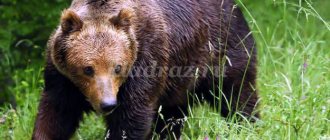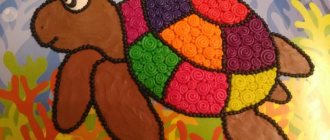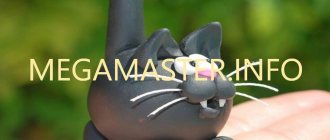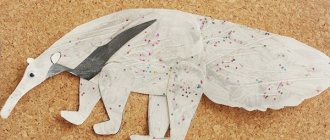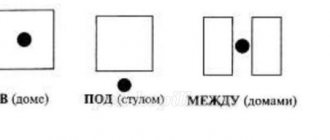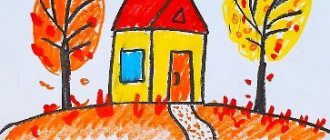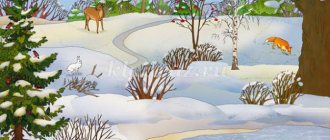Progress of the lesson:
Educator: Guys, today I suggest you go to a clearing where forest animals . Would you like to go with me?
Educator: Well then, grab your hands and follow me.
Educator: guys, look what this is? It looks like these are someone's tracks , but where are the forest animals ? Guys, maybe you know?
(children's opinions are listened to)
.
Educator: It’s possible that they got scared of us and ran away. Let's find them, and we'll look for them by tracks . First, you need to guess who has what marks ? (I help the children guess who has what marks ,
(we found a squirrel in a tree, a fox in a hole, a bunny behind a bush)
.
Educator: clever guys, we found forest dwellers , now let's invite them to visit us (sit down at the tables)
.
Educator: guys, since we invited a bunny, a squirrel and a fox to visit, let's please them and draw pictures for them. (children draw animal tracks with their fingers )
.
Educator: Well done guys, you tried very hard and the drawings turned out beautiful, I think the forest animals will no longer be afraid of us and will come to visit us more than once (children give their drawings)
.
Educator: Kropotova E. G.
Presentation of a group on non-traditional drawing techniques At the age of ten, at seven, and at five All children love to draw. And everyone will boldly draw everything that interests him. Everything is of interest: Distant.
The influence of non-traditional drawing methods on children's positive emotions. From work experience (abstracts) Theses of accumulation of experience in non-traditional drawing techniques for preschoolers of the teacher of MBDOU kindergarten No. 29 Lena Sagitovna Asfatullina.
Source
Summary of a drawing lesson in the second junior group “Wild animals. Hare in the snow"
Zhanara Disingazieva
Summary of a drawing lesson in the second junior group “Wild animals. Hare in the snow"
Topic of the lesson : “ Wild animals . Hare in the snow ."
Goal: to teach children to poke with a hard, semi-dry brush. Develop the ability to listen to a nursery rhyme and imitate the movements of a hare along the text. Give an idea of the life of a hare in the forest in winter.
Objectives: teach children to poke with a hard semi-dry brush inside the contour; convey in the drawing the features of the appearance of the hare. Strengthen technical drawing (hold the brush correctly)
.
Intensify the use of speech words denoting the characteristics of a rabbit’s fur (fluffy, soft, white, etc.)
. Improve dialogic speech. To develop children's aesthetic perception of winter nature. Promote the development of curiosity.
snowfall while walking ; looking at illustrations of bunnies; reading fairy tales.
Demonstration material: bi-ba-bo fox doll.
Handout: album sheet with an outline image of a hare on a blue background; white gouache; hard brush;
Abstract of GCD in junior group 1: Wild animals in winter
Lesson on a winter theme in the 1st junior group.
Abstract Author: Bykova Natalya Ivanovna, teacher. Place of work: MDOU “Child Development Center - kindergarten No. 110 “Little Red Riding Hood”, Petrozavodsk, Republic of Karelia.
Direct educational activities in the 1st junior group.
Topic: “Wild animals in winter.” Educational areas: “Social and communicative development”, “Cognitive development”, “Speech development”, “Physical development”. Goal: To give children an idea of wild animals, their characteristics, habits, and nutrition. Objectives: 1. “Cognitive development”: To form in children ideas about animals - inhabitants of the forest (hare, squirrel, fox, wolf, bear), their appearance, nutrition, and lifestyle features. Talk about how a bear prepares for winter. 2. “Speech development”: Develop children’s speech, the ability to listen to the teacher, answer questions, repeat after the teacher. Develop the ability to solve riddles. Enrich children's vocabulary. Vocabulary work: winter, forest, fox, bear, hare, wolf. 3. “Social-communicative”: Contribute to the creation of a favorable psychological atmosphere in the classroom. Arouse interest in playing together with an adult. Develop the ability to build dialogue with adults and peers. Cultivate interest and love for animals, a desire to care for them. 4. “Physical development”: Learn to move, imitating movements characteristic of a fox, wolf, hare. Develop coordination of movements. Methodological techniques: visual, verbal, game, guessing riddles, artistic expression, questions, surprise moments, musical (“lullaby”). Preliminary work: Learning songs and poems on the theme of wild animals. Situational conversations on this topic. Looking at illustrations of “wild animals”. Russian folk game “Fox and Hares”, “The gray bunny is sitting”, “The bunny is jumping, jumping”. Equipment and material: Composition “Winter Forest”;
wild animal toys: hare, fox, wolf, bear, squirrel; basket; treat for animals: a barrel of honey, raspberries, a toy fish, mushrooms, nuts, meat (a replica from the game “shop”). Progress:
The teacher invites the children to go into the forest.
Educator: Guys, do you want to go into the forest with me? Wild animals live in the forest. Let's get them a treat. On the table are dummies for playing shop: raspberries, a barrel of honey, a toy fish, carrots, mushrooms, nuts, meat. The teacher offers to put all the products in a basket. Children name each item and put it in a basket. Educator : It’s winter now, there’s a lot of snow in the forest. And it’s hard for us to walk in the snow! Let's sit down quietly and I'll tell you a poem about a bear. You can’t find a bear’s trail in winter, Zimushka sent Mishenka to bed. In the den he sucks a sweet paw, And he dreams that he eats honey. Mishka purrs contentedly with joy. Hey, animals, be quiet... Let Misha sleep. (Gusarova T.) The teacher draws the children’s attention to a bear cub lying under a tree. Educator: Hush, children, the bear is sleeping! You won’t see him in the forest in winter, because the bear sleeps in a den for the winter. To make the bear sleep better, let's sing him a lullaby. Children with a teacher sing “Lullaby”, music. E. Tilicheeva, lyrics. N. Naydenova. 1. Bye-bye, bye-bye! Sleep, my teddy bear, go to sleep. 2. Hurry up and close your eye. Get some sleep, get some sleep for an hour. 3. Bye-bye, bye-bye! Sleep, my teddy bear, sleep! The children sing along and lull the bear to sleep. Educator: Guys, what will we give the bear as a gift, what kind of treat? Children choose raspberries and honey, take them out and leave them next to the teddy bear. Educator: The bear will wake up, see raspberries and honey and be happy. Let the little one sleep, and you and I will take a walk through the winter forest. We will walk quietly so as not to wake the bear. The teacher shows a toy hare. Educator: Oh, look, children, who we met in the forest! Who is this? (bunny) What kind of bunny? (white, soft, fluffy). In winter, the bunny's fur is white as snow, so that the wolf and the fox would not notice him in the snow and would not catch him. What kind of ears does the hare have? (long, sensitive - hear well). The bunny wants to play with you. Game with the Hare. There is a snowball on the ground (they run on their toes in a circle) The bunny runs through the snow. Jump - hop, jump - hop (they jump like bunnies) The bunny runs through the snow. Ears are freezing (stroke ears), Paws are freezing (stroke hands). Without boots and without a hat. (show) Jump - hop, hop - hop, (jump like bunnies) The bunny hid in a snowdrift. (squat down). Educator: The bunnies jumped merrily. What will we give the bunny, what does he like to eat? Children choose a carrot and give it to the hare. Educator: Let's say to the bunny: “Eat, bunny, a carrot!” Educator: The hare was delighted with the gift and galloped further into the forest. The bunny runs fast and fast. Educator: Here is a little fox running - her red sister. The teacher shows the children a toy fox. Educator: The fox also doesn’t want to wake up the little one. She walks quietly, on her toes. Can you walk like that? Show it to the fox. Children do an exercise, imitate a fox. Educator: Guys, what kind of fur coat does the fox have? (red, fluffy) What kind of tail does the fox have? (long, fluffy, big). The fox really enjoyed playing with the guys. Shall we treat the fox? What will we choose for the fox? Children choose a fish and treat the fox. Educator: Let's say to the fox: “Eat, little fox, fish!” Educator: The little fox played and ran into the forest to eat fish. Educator: Listen, what forest animal is the riddle about: On a cold, gloomy winter day, a hungry beast walks and wanders. He prowls through forests and fields, And he looks for food for himself. Who is this? (wolf). The teacher shows a toy wolf. Educator: A wolf is hunting in the forest. He walks carefully so as not to frighten other animals. Show how a wolf makes its way through the forest. Children imitate the movements of a wolf. Educator: The wolf is a strong beast. What kind of fur does he have? (thick, gray). What kind of teeth does a wolf have? (spicy). What will we treat the wolf to, what will he like most? (we'll treat you to meat). Educator: Let's say: “Help yourself, little top, gray barrel!” Educator: The gray wolf ran further into the forest to hunt. Educator: It seems like some animal is sitting on a tree. Who is this? The teacher shows a toy squirrel. Educator: Who is this? (squirrel). What squirrel? (fluffy, small). What kind of tail does a squirrel have? (big, fluffy-fluffy). A squirrel lives in a hollow in a tree. She jumps from one tree to another. What does the squirrel like, what can we treat it to? (mushrooms, nuts) Children treat the squirrel. Educator: Let's say: “Help yourself, squirrel! Eat mushrooms and nuts!” Educator: The squirrel climbed onto the highest tree. The wolf won't get her, the fox won't get her. What a clever squirrel. Educator: Children, do you think we didn’t wake up the bear? Let's hear if the bear is growling? Children listen. Educator: You played so quietly that the little one didn’t even wake up. Did you enjoy a walk in the winter forest? Let's remember who lives in the forest? The teacher quietly puts a bag of carrots in the basket. Educator: Now it’s time for us to return to the group. Oh, look, guys, there’s something in our basket. What is this? (carrot). Who do you think put this on us? (bunny). The bunny also wants to treat you. Help yourself to some carrots! Let's say "thank you" to the bunny! It's time for us to return to the group.
We recommend watching:
OD summary on sensory development in the junior group on the topic: Winter Summary of a lesson in the 2nd junior group on the topic: Winter Summary of a lesson on cognitive development in the 2nd junior group on the topic: Winter Summary of a lesson on speech development on the topic: Winter in the 2nd junior group
Similar articles:
Summary of a game lesson for young children on the topic: Winter
Progress of the lesson.
Educator: Guys, listen to the nursery rhyme and you will find out who came to visit us.
Educator: That's right, bunny!
There is a knock on the door.
Educator: I wonder who else came to us?
He brings in the fox: the teacher puts a bi-ba-bo doll on his hand and says on her behalf: “Hello! Whoa, who do I see (a hare, I want to play hide and seek with you. I will turn my back, and you hide."
Educator: Guys, let's help the bunny, otherwise the fox will catch him and eat him! Shall we help the bunny?
Educator: What can we do to save the bunny?
Children's answers. The teacher praises and selects the most successful and inventive answers.
Educator: It’s winter outside, everything is covered with white snow . And the little hares in their gray fur coat stand out against the white snow .
Educator: What color is the fur of bunnies in winter?
Educator: Correct. A white fur coat is needed so that the hare is not visible in the snow . What other kind of fur do rabbits have?
Children: She is fluffy and soft.
Educator: Well done! In order for our bunnies to have the same fur, you need to pick up a little white gouache with a dry, hard brush, and, holding the brush vertically, make pokes on top inside the outline.
drawing methods .
Independent activity of children.
At the end of the lesson, the results are summed up .
Educator: Well done! Look what beautiful white and fluffy bunnies you have made! Well, little fox, you can look for bunnies!
Fox (addressing the children)
: “Now I’ll quickly find the hares.
(Looks at the children's work)
. Where are they? Well, again I couldn’t catch the rabbits. "
Educator: “Well done, guys! They helped the bunnies well.”
Photo report on a drawing lesson with children aged 5–6 years on the topic “Hare in the Snow” Our bunnies are fashionistas, They have changed their frock coats: Nowadays the hares are white, Even though they were grey. In autumn it is easier for gray people to live among gray nature, and in winter it is calmer.
Abstract of an integrated GCD on the topic “Wild animals. Hare" (early age) Purpose: Introducing children to wild animals. Objectives: To introduce children to wild animals; Teach children to understand the question and answer it;
Summary of educational activities for children of the second junior group “Let's help the squirrel. Wild animals" Problems. To consolidate children’s ideas about autumn, its characteristic features, and autumn natural phenomena. Reinforce the concept of “wild animals”.
Abstract of the GCD in the second junior group “Wild animals and their young” Purpose: to summarize children’s ideas about wild animals and their young. Objectives: Educational: Consolidating ideas about features.
Source
Summary of GCD in the 2nd junior group: Wild animals
GCD in the second junior group of kindergarten
Objectives: Educational:
To consolidate children's knowledge about wild animals, their appearance, and the peculiarities of their habits.
Fix the names of the cubs. Specify the name of the dwelling. Consolidate knowledge about basic geometric shapes (circle, square, triangle); about the primary colors (red, blue, yellow, green) and shade - gray. Developmental:
Develop coherent dialogical speech, the ability to coordinate different parts of speech.
Develop attention, memory, thinking. Develop children's creative abilities; Ability to work neatly and cleanly with paints. Educational:
Foster love for the world around us;
Feeling of compassion, desire to help; Cultivate neatness and cleanliness. Equipment:
“Forest” decoration, supplies of squirrels and mushrooms. Slideshow on the projector “Inhabitants of the Forest” For each child, a landscape sheet with the image of a white hare, gray gouache paints, cotton swabs, napkins.
Progress of activities
V.: What a good day today, guests have come to us, let's say hello the way we know how: “Hello, palms - clap, clap, clap. Hello, legs - top, top, top. Hello, cheeks - splash, splash, splash. Round cheeks - splash, splash, splash. Hello, sponges - smack, smack, smack. Hello, teeth - click, click, click. Hello, my nose is bi, bi, bi. Hello, dear guests - hello. Mail: “Come urgently, help urgently! Miracles happen, we cannot divide the forest. The wizard scared us, he bewitched us all. We have forgotten who we are, what we should drink and what we should eat. Help us out, come and make peace between us urgently!” Forest inhabitants. Q: What are the names of the animals that live in the forest? (wild) Q: What wild animals do you know? Q: Why are they called wild? V.: some wizard bewitched all the animals, now they don’t know who they are, what they should eat, where to live, and most importantly, they don’t recognize their cubs. They ask us for help, shall we help? Q: But what can you use to go into the forest? Let's remember what types of transport we know. V.: They travel long distances by plane, the train travels on rails, they sail on the sea by ship, few people can fit in the car. Q: Are there many of us or few? Q: There are a lot of us, and the forest is not far, what can we all ride at the same time? V.: To go by bus, you need to buy tickets and sit in the place where the same figure of the same color is depicted (geometric shapes are glued to the chairs: a square, a circle and a triangle in red, yellow, blue and green colors) An inspector comes in and checks randomly tickets. The song “Bus” by V. sounds: it seems that we have arrived, listen to how the birds sing, how it smells in the forest. It’s very beautiful here, but I don’t see a single forest dweller. The animals are probably very confused, because they have forgotten who they are. 1 slide. Bear.
- who is this? -Tell me, children, what kind of bear is it? (big, brown,
kind, he has powerful paws, small ears) - what is the name of the cub? -What does he like to eat? - but in winter there is no honey and berries, what does the bear do? -Where does he sleep? 2 slide. Bear in a den.
V.: Oh, look, under the bush, under the bush there is Someone with a red tail. Who do you think it is? , 3rd slide Fox.
Q: Look at the fox and tell me what it is like. The fox is red, beautiful, cunning. She has a fluffy, long tail. She is often called plutovka, which means a deceiver. The fox does not change its coat; it is red both in summer and winter. -What is the name of the cub? 4 slide. Nora.
There is a fox's house under the bush. What is the name of the fox's house? V.: The entrance to the hole is narrow, long, and inside the hole is spacious and comfortable. Q: Who knows why the fox needs such a fluffy tail? (cover tracks) V.: let’s show together how a fox walks and covers its tracks. Physical exercise. The fox walked through the forest, made song calls, the fox tore the stripes, the fox wove bast shoes, walked near the Christmas tree, and what did you find on the Christmas tree? Mushrooms? Q: Do mushrooms grow on the Christmas tree? Q: What grows on the Christmas tree? (cones and needles)Where do mushrooms grow? (on the ground) V.: then whose mushrooms are these? (squirrel reserves) Where is the squirrel itself? 5 slide. Squirrel
V.: here she looks at us and asks for help, because she has forgotten who she is. Come on, guys, we'll tell you about her. What kind of coat does a squirrel have? (red, fluffy) Ears, tail? What is a baby squirrel called? (little squirrel) What is the name of her house? (hollow) 6 slide. Squirrel in a hollow.
V.: squirrels make themselves a house high in a tree. Let's show together how high it is. (We stand on our toes) Q: Why do you think the squirrel’s house is so high? (so that other animals cannot get to her or her supplies) V.: All animals have their own houses: the bear has a den, the fox has a hole, the squirrel has a hollow, but where does the hare live? What kind of house does he have? V.: The bunny doesn’t have a house, he slept under a bush and ran away, so he runs fast because there is nowhere to hide. Slide 7 The hare is white.
V.: Here is the bunny, let's look at it together. What kind of ears, tail, fur coat does he have? V.: The hare is a real fashionista: in winter he wears a white fur coat, and in summer he wears a gray one. Why do you think? (to make it easier to hide) Oh, trouble! It’s already spring, but the hare still hasn’t changed his coat, we need help. Painting a white hare gray (using the “poking” method with cotton swabs) 8 slide . The hare is gray.
V.: Look, the hare is already gray, we helped him. Great job guys, well done! Oh, he's already galloped away. Slide 9 Wolf
V.: Another resident showed up. Gray, scary and toothy. Caused a commotion. All the animals ran away. Scared the animals... V.: tell me what he is like? Slide 11 Lair.
V.: The wolf also has a home, look at what it is like. His home is called a lair. Sad music sounds and a wizard appears. V.: wizard, what happened, why are you so sad? Wizard: Yesterday I accidentally bewitched all the animals in the forest. I can’t cast the spell back - I forgot the words. V.: Don’t worry, wizard, we have already helped all the animals. We reminded them who they are, where they live and what they like to eat. V.: Guys, let's tell the wizard what animals we helped. Wizard: Thank you very much, you helped me out so much. Who are you and where did you come from? (from kindergarten) Wizard: what are you doing there? Show how you can dance. Dance “Stamp, my foot” Wizard: my time has come to please you. Close your eyes. The wizard says special words and a huge candy appears. Q: How can we share one candy among everyone? The wizard once again asks you to close your eyes, casts a spell, and many small ones appear from the large candy. The wizard thanks for the help and leaves. V.: oh, guys, it’s already very late, it’s time to go back. The bus ride will be long, so we will return to the group by plane. V.: they started the engines, spread their wings and flew.
We recommend watching:
Summary of GCD for children of the 2nd junior group on the topic: Winter Summary of GCD cognition using ICT in the 2nd junior group. Journey to the autumn forest Lesson notes. Walk through the forest. Senior group About animal houses for preschoolers
Similar articles:
Conversation about the hare for older preschoolers
What can you tell children about a hedgehog?
A story about a squirrel for 1st grade children on the world around them
What can you tell children about the fox?
Conversation about the wolf. Senior - preparatory group
Notes on drawing in the first junior group “Wild Animals. Hedgehog"
Inna Rybkina
Notes on drawing in the first junior group “Wild Animals. Hedgehog"
Summary of GCD for drawing in the first junior group
Goal: Creating the image of a hedgehog in collaboration with the teacher: completing the “needles”
- from short straight lines.
Learn to use a pencil (wax crayon, draw straight lines from top to bottom.
Develop fine motor skills of the hands, develop aesthetic perception. Develop a sense of rhythm and color.
Foster independence in work and a desire to help.
Equipment: Hedgehog toy, sheets of paper depicting a hedgehog without needles, black pencils.
— "Communication"
Activate the words “needles and thorns” in children’s speech. Answer the teacher's questions.
— "Cognition"
Introduce children to
the animal hedgehog (what it is, where it lives)
.
